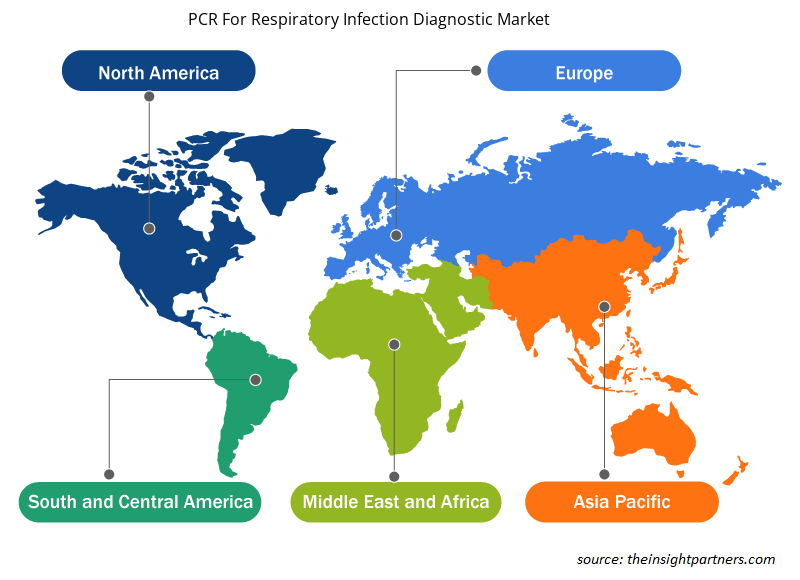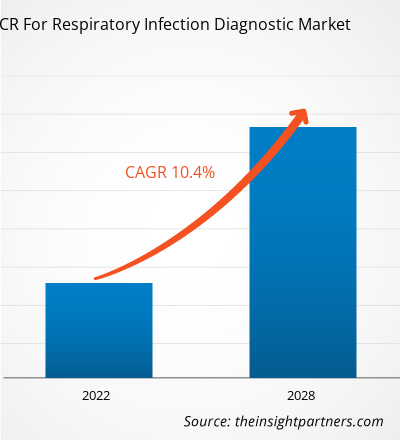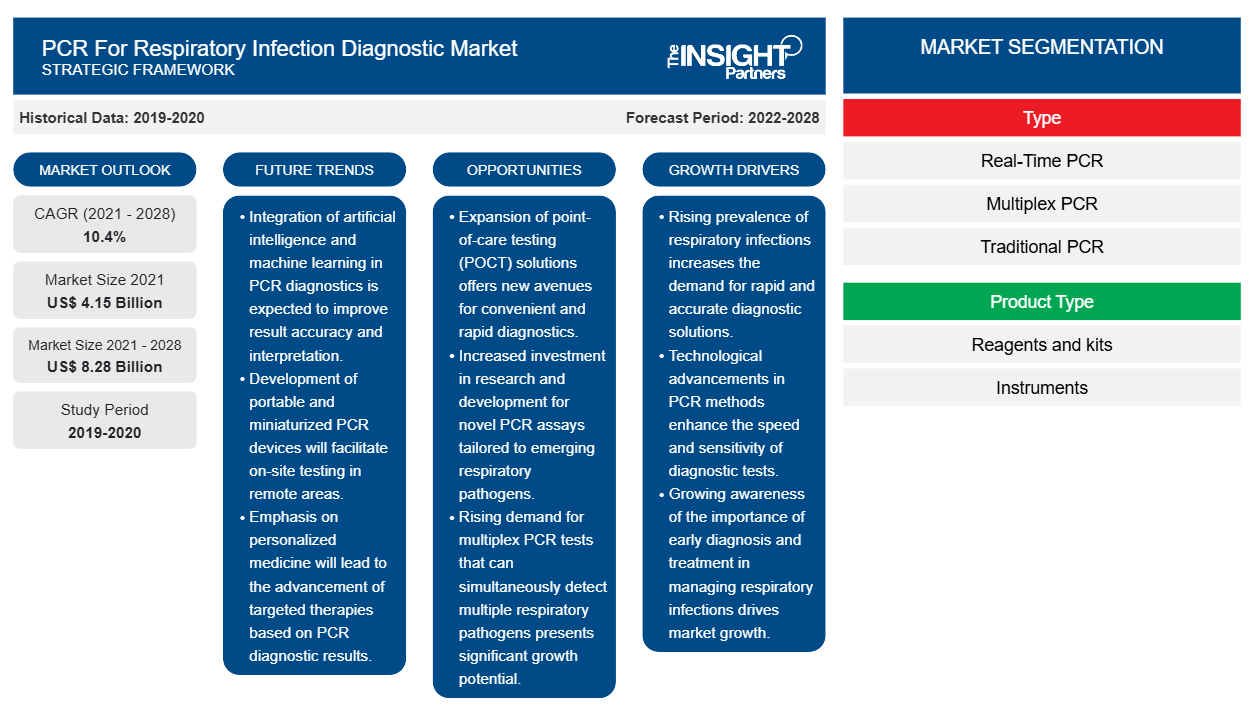El mercado de PCR para diagnóstico de infecciones respiratorias se valoró en US$ 8279,32 millones en 2028 desde US$ 4146,02 millones en 2021; se estima que crecerá a una CAGR del 10,4% entre 2021 y 2028.
La reacción en cadena de la polimerasa (PCR) se utiliza para realizar diagnósticos precisos en el punto de atención que ayudan a identificar y determinar rápidamente la causa de las infecciones del tracto respiratorio. Además, la PCR es ampliamente preferida en entornos hospitalarios y ambulatorios, lo que ayuda a impulsar el crecimiento del mercado en los últimos años.
El crecimiento del mercado de PCR para el diagnóstico de infecciones respiratorias se atribuye a factores como la creciente carga de enfermedades respiratorias crónicas (ERC), los avances en las pruebas de PCR, que están mejorando ampliamente el rendimiento de los dispositivos médicos. Sin embargo, el uso de pruebas de PCR para diversos diagnósticos de infecciones respiratorias y los avances en la tecnología de PCR que se utilizan para obtenerlas. La disponibilidad de ensayos alternativos obstaculiza el crecimiento del mercado.
Personalice este informe según sus necesidades
Obtendrá personalización en cualquier informe, sin cargo, incluidas partes de este informe o análisis a nivel de país, paquete de datos de Excel, así como también grandes ofertas y descuentos para empresas emergentes y universidades.
- Obtenga las principales tendencias clave del mercado de este informe.Esta muestra GRATUITA incluirá análisis de datos, desde tendencias del mercado hasta estimaciones y pronósticos.
Perspectivas del mercado
Estrategias de consolidación de mercado adoptadas mediante el uso de pruebas PCR para el diagnóstico de diversas infecciones respiratorias
Las pruebas de PCR son el estándar de oro para detectar enfermedades infecciosas respiratorias, incluido el SARS-CoV-2. Además, los crecientes avances en PCR no se limitan a las pruebas de COVID-19. Los continuos avances tecnológicos han permitido a los investigadores desarrollar técnicas de PCR avanzadas a un costo reducido y limitar sus complejidades. Se espera que las pruebas de PCR mejoren sus capacidades para el diagnóstico molecular y fortalezcan su papel en el futuro con los avances en curso de tecnologías como la microfluídica y la secuenciación de próxima generación . Además, las pruebas de PCR se utilizan significativamente en instituciones como hogares de ancianos, centros de atención crónica y hospitales, para identificar la infección por el virus de la influenza que causa brotes respiratorios.
Además, las infecciones respiratorias agudas y crónicas se encuentran entre las principales causas de morbilidad en los países desarrollados y en desarrollo a nivel mundial. Se estima que las enfermedades respiratorias agudas representan casi el 75% de la morbilidad aguda total a nivel mundial. Por lo tanto, varias empresas ofrecen diversos kits de PCR que pueden detectar la presencia de patógenos que causan enfermedades respiratorias. Por ejemplo, empresas como bioMérieux SA y altona Diagnostics GmbH ofrecen una amplia gama de kits de PCR que pueden detectar infecciones respiratorias agudas en el tracto respiratorio superior o inferior. Aparte de la creciente incidencia de enfermedades respiratorias agudas y crónicas, es probable que otros factores como las condiciones ambientales y climáticas, la contaminación del aire y los descubrimientos de nuevas bacterias, virus y patógenos sirvan como oportunidades de crecimiento vitales para las pruebas de PCR para el diagnóstico de infecciones respiratorias en el futuro próximo.
Perspectivas basadas en tipos
El mercado de PCR para el diagnóstico de infecciones respiratorias, por tipo, se segmenta en PCR en tiempo real (qPCR), PCR multiplex, PCR tradicional, PCR digital, transcriptasa inversa (RT-PCR) y otros. El segmento de PCR en tiempo real (qPCR) tuvo la mayor participación del mercado en 2021 y se prevé que registre la CAGR más alta del mercado durante el período de pronóstico.
Información basada en el tipo de producto
Según el tipo de producto, el mercado de PCR para el diagnóstico de infecciones respiratorias se segmenta en reactivos y kits, instrumentos y otros. El segmento de reactivos y kits tuvo la mayor participación del mercado en 2021 y se prevé que registre la CAGR más alta del mercado durante el período de pronóstico.
Información basada en el tipo de infección
Según el tipo de infección, el mercado de PCR para el diagnóstico de infecciones respiratorias se segmenta en infecciones bacterianas, infecciones virales, hongos y otros patógenos. En 2021, el segmento de infecciones virales tuvo la mayor participación del mercado y se estima que registrará la CAGR más alta del mercado durante el período de pronóstico.
Información basada en los usuarios finales
Según el usuario final, el mercado de PCR para el diagnóstico de infecciones respiratorias está segmentado en hospitales, clínicas médicas, laboratorios clínicos, instituciones académicas y de investigación, empresas biotecnológicas y farmacéuticas, entre otros. En 2020, el segmento de laboratorios clínicos tuvo la mayor participación del mercado y se estima que registrará la CAGR más alta del mercado durante el período de pronóstico.
Los lanzamientos y aprobaciones de productos son estrategias que las empresas suelen adoptar para ampliar su presencia global y sus carteras de productos. Además, los actores del mercado de reconstrucción mamaria se centran en la estrategia de colaboración para ampliar su clientela, lo que, a su vez, les permite mantener su marca a nivel mundial.
Perspectivas regionales del mercado de PCR para el diagnóstico de infecciones respiratorias
Los analistas de Insight Partners explicaron en detalle las tendencias y los factores regionales que influyen en el mercado de PCR para el diagnóstico de infecciones respiratorias durante el período de pronóstico. Esta sección también analiza los segmentos y la geografía del mercado de PCR para el diagnóstico de infecciones respiratorias en América del Norte, Europa, Asia Pacífico, Oriente Medio y África, y América del Sur y Central.

- Obtenga datos regionales específicos para el mercado de PCR para diagnóstico de infecciones respiratorias
Alcance del informe de mercado de PCR para diagnóstico de infecciones respiratorias
| Atributo del informe | Detalles |
|---|---|
| Tamaño del mercado en 2021 | US$ 4,15 mil millones |
| Tamaño del mercado en 2028 | US$ 8,28 mil millones |
| CAGR global (2021-2028) | 10,4% |
| Datos históricos | 2019-2020 |
| Período de pronóstico | 2022-2028 |
| Segmentos cubiertos | Por tipo
|
| Regiones y países cubiertos | América del norte
|
| Líderes del mercado y perfiles de empresas clave |
|
Densidad de actores del mercado de PCR para diagnóstico de infecciones respiratorias: comprensión de su impacto en la dinámica empresarial
El mercado de PCR para el diagnóstico de infecciones respiratorias está creciendo rápidamente, impulsado por la creciente demanda de los usuarios finales debido a factores como la evolución de las preferencias de los consumidores, los avances tecnológicos y una mayor conciencia de los beneficios del producto. A medida que aumenta la demanda, las empresas amplían sus ofertas, innovan para satisfacer las necesidades de los consumidores y aprovechan las tendencias emergentes, lo que impulsa aún más el crecimiento del mercado.
La densidad de actores del mercado se refiere a la distribución de las empresas o firmas que operan dentro de un mercado o industria en particular. Indica cuántos competidores (actores del mercado) están presentes en un espacio de mercado determinado en relación con su tamaño o valor total de mercado.
Las principales empresas que operan en el mercado de PCR para diagnóstico de infecciones respiratorias son:
- Abad
- F. Hoffmann-La Roche AG
- Fabricante: Hologic, Inc.
- Compañía Seegene Inc.
- AusDiagnóstico
Descargo de responsabilidad : Las empresas enumeradas anteriormente no están clasificadas en ningún orden particular.

- Obtenga una descripción general de los principales actores clave del mercado de PCR para diagnóstico de infecciones respiratorias
Por tipo
- PCR en tiempo real (qPCR)
- PCR multiplexada
- PCR tradicional
- PCR digital
- Transcriptasa inversa (RT-PCR)
- Otros
Por tipo de producto
- Reactivos y kits
- Instrumentos
- Otros
Por tipo de infección
- Infecciones bacterianas
- Bordetella
- Neumonía por estreptococo
- Estafilococo áureo
- Haemophilus influenzae
- Moraxella catarrhalis
- Neumonía por micoplasma
- Chlamydophila neumoniae (neumonía por clamidia)
- Legionella
- Otros
- Infecciones virales
- Rinovirus
- Virus de la gripe
- Virus del síndrome respiratorio agudo severo (SARS) CoV-2
- Virus respiratorio sincitial (VSR)
- Adenovirus
- Enterovirus
- Parainfluenza
- Metaneumovirus humano (hMPV)
- Otros
- Hongos y otros patógenos
Por el usuario final
- Hospitales
- Clínicas médicas
- Laboratorios clínicos
- Instituciones académicas y de investigación
- Empresas biotecnológicas y farmacéuticas
- Otros
Por geografía
- América del norte
- A NOSOTROS
- Canadá
- México
- Europa
- Francia
- Alemania
- Reino Unido
- España
- Países Bajos
- Noruega
- Italia
- Resto de Europa
- Asia Pacífico (APAC)
- Porcelana
- India
- Japón
- Australia
- Corea del Sur
- Resto de Asia Pacífico
- Oriente Medio y África (MEA)
- Arabia Saudita
- Emiratos Árabes Unidos
- Sudáfrica
- Resto de Oriente Medio y África
- América del Sur y Central (SCAM)
- Brasil
- Argentina
- Resto de América del Sur y Central
Perfiles de empresas
- Abad
- F. Hoffmann-La Roche AG
- Fabricante: Hologic, Inc.
- Compañía Seegene Inc.
- AusDiagnóstico
- BD
- Laboratorios Bio-Rad Inc.
- BioMérieux
- Qiagen
- Thermo Fisher Scientific Inc
- Análisis histórico (2 años), año base, pronóstico (7 años) con CAGR
- Análisis PEST y FODA
- Tamaño del mercado, valor/volumen: global, regional y nacional
- Industria y panorama competitivo
- Conjunto de datos de Excel
Informes recientes
Testimonios
Razón para comprar
- Toma de decisiones informada
- Comprensión de la dinámica del mercado
- Análisis competitivo
- Información sobre clientes
- Pronósticos del mercado
- Mitigación de riesgos
- Planificación estratégica
- Justificación de la inversión
- Identificación de mercados emergentes
- Mejora de las estrategias de marketing
- Impulso de la eficiencia operativa
- Alineación con las tendencias regulatorias





















 Obtenga una muestra gratuita para - Mercado de PCR para el diagnóstico de infecciones respiratorias
Obtenga una muestra gratuita para - Mercado de PCR para el diagnóstico de infecciones respiratorias